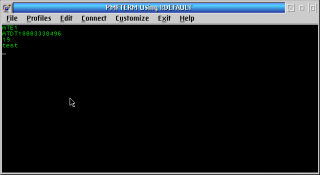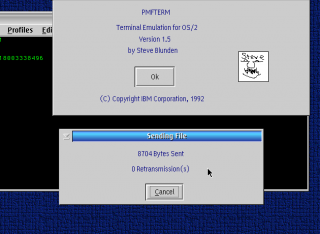|
PMFTERM v. 1.5 (23/3/1993, International Business Machines Corporation (IBM)) |
Readme/What's new |
PMFTERM 1.5
Release History
---------------
Release 1.2 Initial release of PMFTERM
Release 1.3 8/31/92
Added \o to autokey sequences to allow sending a
CTRL-E to certain ROLM switches.
Fixed a data integrity bug in XMODEM download. Under
certain circumstances the receive block count could
be updated when in fact the block was received with
bad checksum/CRC, causing loss of data in increments
of the receive block size (128/1024) with no error
messages.
Release 1.4 9/7/92
Added File Capture mode. Selecting File Capture from
the action bar tells PMFTERM to start saving line input
data in a 64KB buffer. The data is saved in raw format,
ie. all escape sequences are stored, as well as control
characters. Unpredictable results may occur if binary
data such as XMODEM file transfer is captured.
When the File Capture menu item is unchecked the contents
of the capture buffer are saved in the clipboard, where
they can be retrieved by an editor and view or saved
in a file.
This release was never available outside of IBM.
Release 1.5a 9/20/92
PMFTERM now changes the Task List when the profile
is changed, so that the name in the Task List matches
the PMFTERM title bar.
A beep is sounded when Print Screen complete.
Another thread added to handle keyboard input.
This release was never available outside of IBM.
Release 1.5 2/11/93
Fixed problem with TSO where screen was cleared
before entering IND$FILE command.
Fixed problems with IND$FILE and 3174 AEA.
Added support in FTTERMC for Host Directed Print.
Output is sent to the spooler default printer, which
is assumed to be IBM4201 data stream compatible.
Fixed ATTN key (Alt+F5).
Fixed cursor in the middle of fonts larger than 10 high.
End of Release History
----------------------
Welcome to PMFTERM! I have tried to implement a version of FTTERM
for OS/2, without having to resort to EE CM.
*************************************************************************
PLEASE NOTE THAT ASCII-EBCDIC TRANSLATION MAY NOT BE FTTERM-COMPATIBLE FOR
CERTAIN SPECIAL CHARACTER CODES SUCH AS [, ], \, ^ AND A FEW OTHERS!
*************************************************************************
Select Menu Item "Help + Help Index..." and browse it for a good description
of PMFTERM.
Keyboard mapping can't be changed. The following codes are assigned:
(left) ENTER - New Line key on Enhanced Keyboards,
Enter key on AT keyboard.
(pad) ENTER - Enter key on Enhanced Keyboards
HOME and PAUSE - Clear Screen (FTTERM/VT100 only)
END - Erase to End of Line (FTTERM only)
F1-F12 - Program function keys for 3708/7171
Shift+F1/F2 - F11 or F12 on 10 PF key keyboards
Ctrl+F1 and Alt+Insert - PA1 (FTTERM/VT100 only)
Ctrl+F2 and Alt+Home - PA2 (FTTERM/VT100 only)
Alt+F5 - ATTN (FTTERMC+3708/3174 only)
Right CTRL key on enhanced keyboards - Enter (FTTERM only)
Ctrl+r - 3708/7171 Reset sequence
Ctrl+n - IBM 5842 <Com> command
Ctrl+s/q/o - Xoff/Xon/SI commands (mainly VT100)
Ctrl+C - Break
-----------------------------------------------------------------------
I N S T A L L A T I O N
1. Download PMFTRM.ZIP and unZip it to a directory.
2. Add one of the following lines to your CONFIG.SYS :
DEVICE=C:\OS2\COM01.SYS (AT type machines Release 1.2+)
DEVICE=C:\OS2\COM02.SYS (PS/2 machines OS/2 1.2+)
DEVICE=C:\OS2\COM.SYS (Version 2.0 and above)
3. PCASSI 3.0 Users can use the provided .CUS file. This customization
file invokes PSEND/PRECEIVE instead of SEND/RECEIVE, and uses host
session "I" instead of "A" as the default.
4. Run PMTDFLTS from an OS/2 windowed command prompt. This will
create a number of useful model terminal profiles which can be used
as a basis for your own profiles.
5. Copy PMFTERM.HLP from your directory into a directory in the HELP= path.
6. To setup a terminal profile "on the fly", (for example, the IBM
Information Network using FTTERM Color emulation mode) execute
PMFTERM.EXE from the OS/2 command prompt and do the following:
Select "Settings" "Select Profile" from the menu bar.
Change the name "DEFAULT" to "FTTERMC" or anything else.
Change Terminal Emulation to FTTERMC.
Set the Modem Speed for your modem.
Set COM1-4.
Push the "Keys" pushbutton.
Configure the autokey sequences for IIN as follows:
Send: ATE1\r (the \r is "return")
Response: OK (wait for OK)
Send: ATDT18003338496\r (dial IIN)
Response: TYPE: (wait for Terminal TYPE:)
Send:19\r (type code for FTTERM)
Response: ===> (wait for response)
Send: xxxx\tyyyyyyyy (account code=xxxx, \t=Tab, userid)
Push the OK button.
Check the "Save" and "Default" check boxes, and push the "OK" button.
The system will now dial IIN. To abort an autokey sequence, select
"Connect" "Abort" from the Menu
and hit any key on the keyboard to kill the ATDT in the modem.
The default (startup) profile is now set to FTTERMC (with your autokey
sequences) and will be selected at startup time.
To redial, select
"Connect" "Connect" from the Menu.
------------------------------------------------------------------------
Allowed Autokey escape (\) sequences:
\r Send a carriage return
\t or \> Send a tab
\< Send a backtab
\n Send a new line
\d Send the IBM 5842 CTRL-N character
\c Send a Ctrl+C (ETX)
\w Wait 1 second
\o Send CTRL-E to R<O>LM switch ** new 1.3 **
\e Send an ESC character
For anything else, the '\' is ignored and the character following it is
sent "as-is". To send a '\', therefore, put a '\\' in the autokey
sequence to be sent.
-------------------------------------------------------------------------
You can create any number of profiles. Check the "Save" checkbox and
overtype the name of the profile to be saved. To use a profile at
startup time (ie. override the DEFAULT profile) either change the Program
Properties "Parameters" to the name of the profile, or go to the OS/2
Windowed Command Prompt and type:
PMFTERM [[x:]MYPROF]
where MYPROF is the name of the profile to be used instead of DEFAULT,
and x: is a single character "session id" which is followed by a colon.
The session id is used to name internal queues and PMFTERM will ensure
that it is unique to each instance of the PMFTERM program in the system.
The session ID is used as part of the host file transfer PSEND/PRECEIVE
command to point to the correct instance of PMFTERM, such that if you
start PMFTERM against COM1 and then again against COM2 (hopefully you
have 2 COM ports and modems available) you could open a windowed OS/2
command prompt and use the commands:
start psend c:\autoexec.bat i:autoexec batbin
start psend c:\config.sys j: (X 1K)
to initiate concurrent file transfers (first to the IBM Information
Network on session "i" and concurrently to a BBS using XMODEM with 1k
blocks). Note that the PMFTERM title bar will say
"PMFTERM Using ?:!!!!!!!!", where ? is the session ID and
!!!!!!!! is the profile name.
Color remapping is now available for FTTERM emulation. Select Customize
Colors, select the color to be changed via its radio button and then
select the color from the "To" box. Press "Set". To reset to the
factory-installed defaults, press "Reset". To write the colors to OS2.INI
press "Save".
Steve Blunden
February 11, 1993 |






Aggiungi un commento